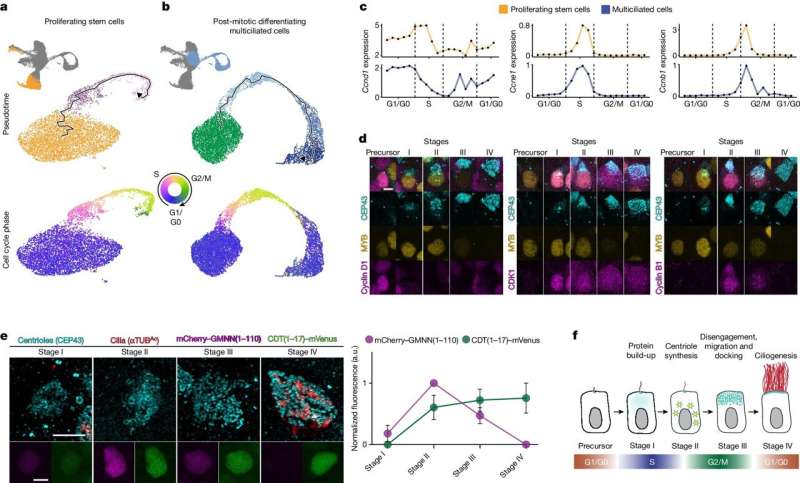This article has been reviewed according to Science X's editorial process and policies. Editors have highlighted the following attributes while ensuring the content's credibility:
fact-checked
peer-reviewed publication
trusted source
proofread
Scientists discover new role of cell cycle in cilia formation

The awe-inspiring process of cell division can turn a fertilized egg into a baby—or a cancerous cell into a malignant tumor. With so much at stake, nature keeps it tightly controlled in a process called the cell cycle that scientists thought they thoroughly understood.
But now it turns out there was more to know. Scientists at UC San Francisco have discovered that cells can also use the cell cycle to control how they sprout hair-like projections called cilia.
"The cell cycle has been studied intensively for decades and here, we've found it working in a new way," said Jeremy Reiter, Ph.D., UCSF professor of biophysics and biochemistry and senior author of the paper, which appeared in Nature on May 29, 2024. "This old dog—the cell cycle—is capable of more tricks than we realized."
Breaking a rule that prevents cancer
Multiciliated cells are crucial to human health. In the lungs, their cilia sway back and forth to keep fluids like mucus from collecting. In the reproductive system, they help move eggs through the fallopian tubes and into the uterus. And in the brain, they sweep out cerebrospinal fluid to remove waste. When they malfunction, serious disease follows.
Reiter and his colleagues wanted to understand how these cells develop, so they used a technique called single cell RNA sequencing to see which genes turned on and off in individual multiciliated cells in the lungs.
They captured them at different stages of maturity, hoping to glimpse the genetic instructions it takes to grow cilia and found a pattern that looked like the cell cycle.
Previous studies had found that a few cell cycle proteins, called cyclins, were active during cilia growth, as well as centrioles, which anchor the two sets of chromosomes during cell division.
Yet Reiter's team found that many cell cycle genes, far beyond just the cyclins, were expressed at high levels in the lung cells, even though the cells weren't dividing.
"In developing multiciliated cells, we saw the same sequential expression of cell cycle regulators, like cyclins and CDKs, that we'd expect to see in stem cells," said Semil Choksi, Ph.D., a researcher in the Reiter lab and first author of the paper.
Clearly, this wasn't the typical cell cycle. For one, this alternative cell cycle, or "multiciliation cycle," as the scientists dubbed it, was producing an unusually high number of centrioles, much more than the four centrioles made during cell division.
"If you have something go wrong in the cell cycle, and you make too many centrioles, it can lead to cancer," Choksi said. "Somehow, this strict cancer-preventing rule, no more than four centrioles per cell, is very specifically broken in multiciliated cells to make hundreds of centrioles."
The cellular orchestra plays something new
Choksi and Reiter took a closer look at how the multiciliation cycle in lung cells differed from the classic cell cycle in dividing stem cells, gene by gene. A particular gene, called E2F7, stood out. Its expression was middling in stem cells, but notably high in maturing, multiciliated cells.
Indeed, when E2F7 was completely disabled, or knocked out, in an animal model, multiciliated cells failed to develop correctly, leading to problems in the brain.
"We thought one of the knobs that evolution might have turned was by upregulating E2F7, to change the canonical cell cycle into the multiciliation cycle," said Reiter.
The scientists then found that multiciliated cells that lacked E2F7 started to synthesize new DNA—a hallmark of cell division. And hundreds of centrioles, intended for eventual construction of cilia at the cell surface, got stuck in the cell body.
If the cell cycle were like a particular score played by a molecular orchestra, E2F7 was a new conductor, guiding the same instruments in that orchestra to play a new tune, the multiciliation cycle.
"Evolution clearly has adapted the cell cycle to carry out a variety of cellular projects well beyond cell division," said Reiter. "It'll be exciting to see what else it's capable of."
More information: Semil P. Choksi et al, An alternative cell cycle coordinates multiciliated cell differentiation, Nature (2024). DOI: 10.1038/s41586-024-07476-z
Journal information: Nature
Provided by University of California, San Francisco




















